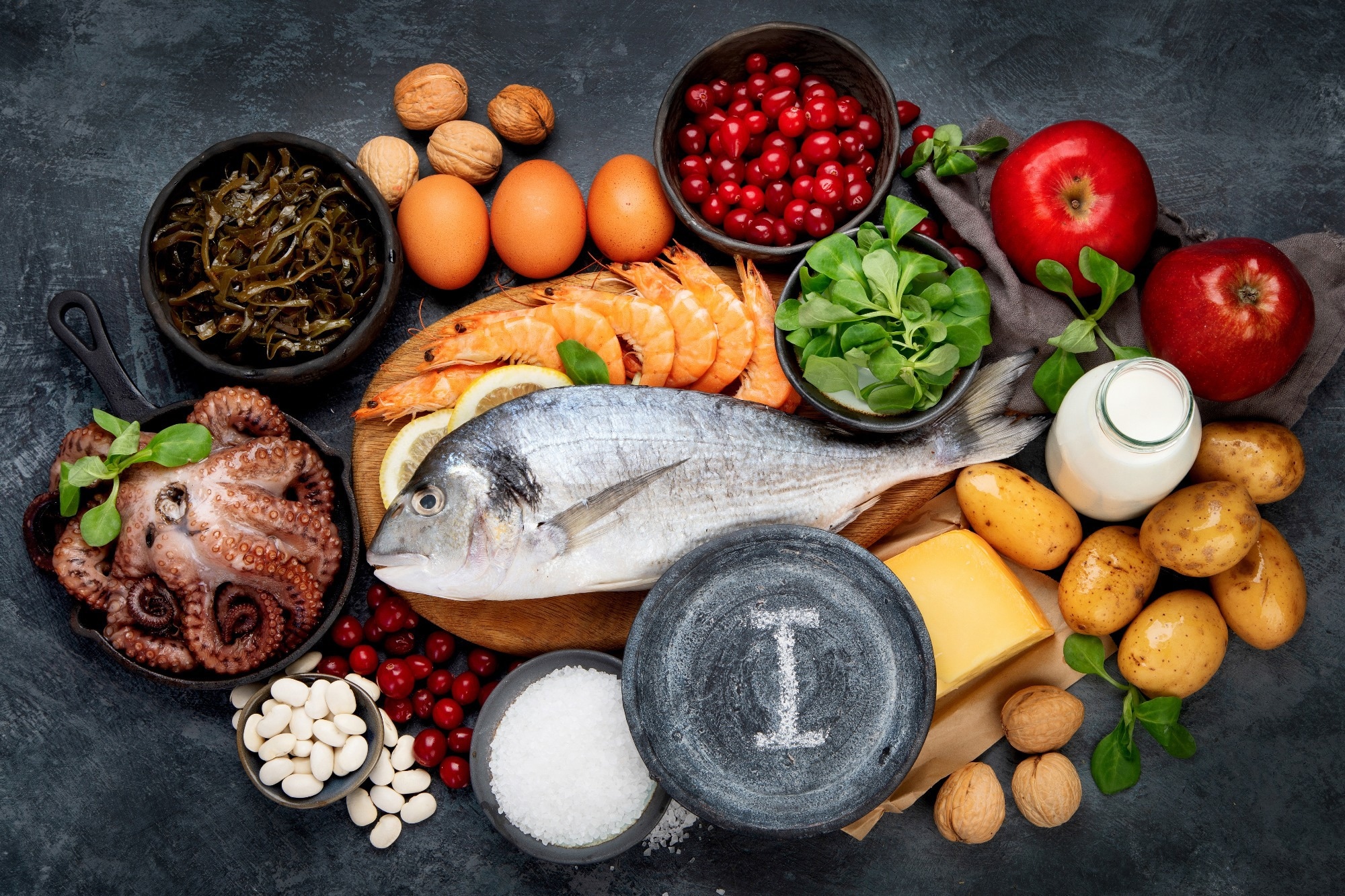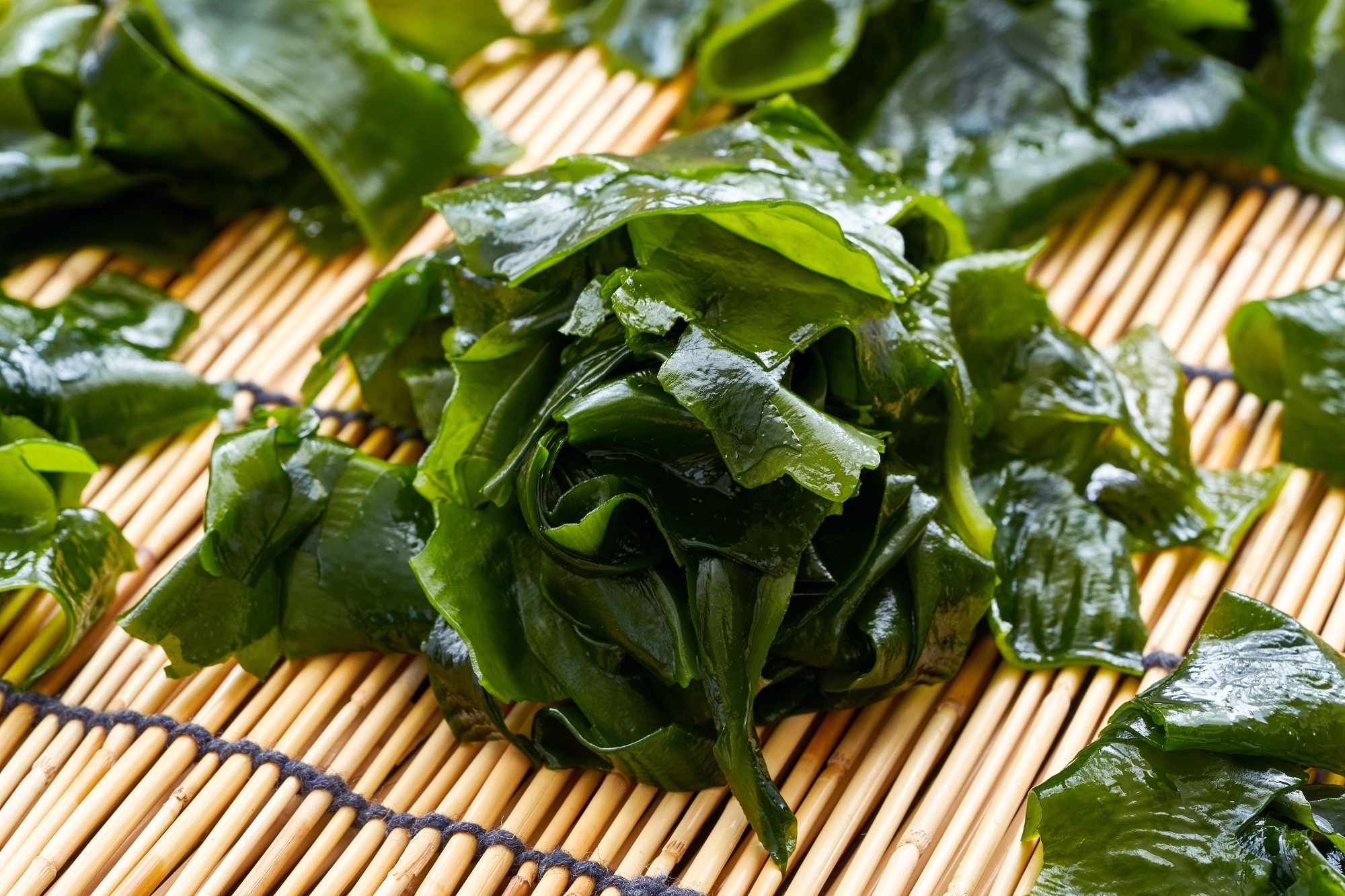Introduction
What is iodine and why is it important?
Iodine-rich foods
Health benefits of adequate iodine
Recommended intake and deficiency risks
Safety and excess intake
Conclusions
References
Further reading
Adequate iodine intake is essential for healthy thyroid function, metabolism, and brain development, yet both deficiency and excess remain global health challenges. This article highlights natural iodine sources, dietary variations, and strategies for achieving safe and sufficient intake.
 Selected food rich in iodine. Image Credit: Tatjana Baibkova / Shutterstock.com
Selected food rich in iodine. Image Credit: Tatjana Baibkova / Shutterstock.com
Introduction
Iodine is a core component of thyroxine (T4) and triiodothyronine (T3), both of which are thyroid hormones that regulate metabolism, growth, and neurological development.1,2 Unlike most other minerals, iodine cannot be synthesized by the body and must be obtained through diet.1,2,3
Despite public health advances, iodine deficiency still affects over 1.8 billion people worldwide, though the number of iodine-sufficient countries has nearly doubled since 2003 due to expanded salt iodization programs. Collectively termed Iodine Deficiency Disorders (IDD), these conditions include goiter, hypothyroidism, and neurodevelopmental impairment such as cretinism.1,3,4
Recent WHO monitoring shows that while 88% of the global population uses iodized salt, mild-to-moderate deficiency persists in at least 21 countries, particularly among vulnerable populations such as pregnant women and those on restrictive diets.1,3
What is iodine and why is it important?
Iodine is absorbed in the stomach and duodenum primarily as iodide. The adult body contains approximately 15–20 mg, of which 70–80% resides in the thyroid gland.2,6 Iodine’s main physiological role is to support thyroid hormone synthesis and maintain metabolic balance.2
According to current NIH data, thyroid hormone synthesis involves iodine uptake via the sodium–iodide symporter (NIS) and incorporation into tyrosine residues on thyroglobulin, forming T3 and T4. This process is tightly regulated by thyroid-stimulating hormone (TSH).2,5
During iodine deficiency, elevated TSH stimulates thyroid hypertrophy (goiter formation) as a compensatory mechanism.2
Iodine-rich foods
The iodine content of food varies geographically due to soil composition and agricultural practices. Marine foods accumulate iodine from seawater and are the richest natural sources.2,7,8
Seaweeds such as Saccharina japonica (sea tangle/kelp) and Undaria pinnatifida (wakame) can contain hundreds to thousands of milligrams of iodine per kilogram dry weight, though content is highly species- and region-dependent. Recent Korean analyses report average iodine levels of 2,432 mg/kg in sea tangle, with safety concerns for excessive intake in frequent consumers.8,9

Saccharina japonica (sea tangle/kelp). Image Credit: boommaval / Shutterstock
Dairy and eggs contribute substantially to iodine intake in many regions. A 2024 meta-analysis found mean milk-iodine concentrations ranging from 5.5 to 49.9 µg/100 g globally, with conventional milk averaging higher iodine levels than organic milk, and winter milk exceeding summer milk by about 6 µg/100 g. Plant-based milk alternatives generally provide negligible iodine unless fortified.7,10
Fish, shellfish, and iodized salt remain globally important dietary iodine sources. In contrast, inland plant foods often have less than 20 µg/kg, making iodized salt programs essential for adequate intake.1,2,3
Iodine Content of Selected Foods2
| Food |
Micrograms (mcg) per serving |
Percent DV* |
| Bread, white, enriched, made with iodate dough conditioner, 2 slices** |
296 |
197 |
| Bread, whole-wheat, made with iodate dough conditioner, 2 slices** |
273 |
182 |
| Cod, baked, 3 ounces |
146 |
97 |
| Seaweed, nori, dried, 2 tablespoons, flaked (5 g) |
116 |
77 |
| Oysters, cooked, 3 ounces |
93 |
62 |
| Yogurt, Greek, plain, nonfat, ¾ cup |
87 |
58 |
| Milk, nonfat, 1 cup |
84 |
56 |
| Iodized table salt, ¼ teaspoon |
78 |
52 |
| Fish sticks, cooked, 3 ounces |
57 |
38 |
| Egg, hard boiled, 1 large |
31 |
21 |
| Pasta, enriched, boiled in water with iodized salt, 1 cup |
30 |
20 |
| Ice cream, chocolate, ⅔ cup |
28 |
19 |
| Cheese, cheddar, 1 ounce |
14 |
9 |
| Liver, beef, cooked, 3 ounces |
14 |
9 |
| Shrimp, cooked, 3 ounces |
13 |
9 |
| Tuna, canned in water, drained, 3 ounces |
7 |
5 |
| Fruit cocktail in light syrup, canned, ½ cup |
5 |
3 |
| Fish sauce, 1 tablespoon |
4 |
3 |
| Beef, chuck, roasted, 3 ounces |
3 |
2 |
| Soy beverage, 1 cup |
3 |
2 |
| Chicken breast, roasted, 3 ounces |
1 |
1 |
| Apple juice, 1 cup |
1 |
1 |
| Bread, whole-wheat, made without iodate dough conditioner, 2 slices** |
1 |
1 |
| Bread, white, enriched, made without iodate dough conditioner, 2 slices** |
1 |
1 |
| Sea salt, noniodized, ¼ teaspoon |
0 |
0 |
| Rice, brown, cooked, ¾ cup |
0 |
0 |
| Corn, canned, ½ cup |
0 |
0 |
| Broccoli, boiled, ½ cup |
0 |
0 |
| Banana, 1 large |
0 |
0 |
| Soy sauce, 1 tablespoon |
0 |
0 |
| Lima beans, boiled, ½ cup |
0 |
0 |
| Green peas, boiled, ½ cup |
0 |
0 |
| Pasta, enriched, boiled in water without iodized salt, 1 cup |
0 |
0 |
*DV = Daily Value. The U.S. Food and Drug Administration (FDA) developed DVs to help consumers compare the nutrient contents of foods and dietary supplements within the context of a total diet. The DV for iodine is 150 mcg for adults and children age 4 years and older [12]. FDA does not require food labels to list iodine content unless iodine has been added to the food. Foods providing 20% or more of the DV are considered high sources of a nutrient, but foods providing lower percentages of the DV also contribute to a healthful diet. **About 20% of bread products in the United States list iodate dough conditioners on their labels. Products made without these conditioners contain very little iodine.
Health benefits of adequate iodine
Adequate iodine ensures normal thyroid function, preventing goiter, hypothyroidism, and developmental disorders. Iodine-based thyroid hormones are critical for fetal brain and skeletal development, and even mild deficiency during pregnancy has been associated with reduced offspring IQ and learning outcomes.1,2,4,5
Meta-analyses indicate that children in iodine-deficient areas may score 8–13 IQ points lower on average compared to iodine-sufficient peers.1
Recent Nordic and WHO reviews emphasize that iodine sufficiency protects against both cognitive impairment and thyroid nodular disease, highlighting its continued public health priority.3,5
Recommended intake and deficiency risks
The Recommended Dietary Allowance (RDA) for adults is 50 µg/day, increasing to 220 µg/day during pregnancy and 290 µg/day while lactating, consistent with WHO and NIH guidelines.2,5,6
Deficiency remains most prevalent in pregnant and lactating women, vegans, and those avoiding iodized salt or seafood. A 2023 systematic review found that vegans have median urinary iodine concentrations of only ~12 µg/L, well below the optimal range of 100–200 µg/L.7
Common symptoms of deficiency include fatigue, weight gain, goiter, and cognitive slowing.2–4
Safety and excess intake
Iodine has a U-shaped relationship with thyroid health: both deficiency and excess can cause dysfunction.5 The Tolerable Upper Intake Level (UL) for adults is 1,100 µg/day.2
Excessive intake can lead to iodine-induced hypothyroidism (failure to escape from the Wolff–Chaikoff effect) or hyperthyroidism (Jod–Basedow phenomenon), especially in individuals with preexisting thyroid conditions.4,6
Recent reviews confirm that high-iodine seaweed consumption, use of iodinated contrast agents, and certain medications such as amiodarone are major contributors to iodine excess in susceptible populations.6,9
Conclusions
Iodine is essential for thyroid hormone synthesis and neurological development, especially during fetal and early life stages. While global iodine nutrition has improved markedly through universal salt iodization, gaps remain among plant-based consumers and pregnant women.1,3,7
Future public health approaches should combine sustained salt iodization, better fortification of plant-based foods, and targeted monitoring of iodine intake to prevent both deficiency and excess worldwide.1,3,5
References
- Zimmermann, M. B., & Andersson, M. (2021). GLOBAL ENDOCRINOLOGY: Global perspectives in endocrinology: coverage of iodized salt programs and iodine status in 2020. European Journal of Endocrinology, 185(1), R13–R21. DOI:10.1530/eje-21-0171, https://academic.oup.com/ejendo/article/185/1/R13/6654349.
- National Institutes of Health, Office of Dietary Supplements. (05 November 2024). Iodine: Fact Sheet for Health Professionals. https://ods.od.nih.gov/factsheets/Iodine-HealthProfessional/. Accessed 03 October 2025.
- World Health Organization. (2022). Expert Group for Updating Guidance on Indicators for the Assessment of Iodine Status. https://www.who.int/groups/expert-group-for-updating-guidance-on-indicators-for-the-assessment-of-iodine-status. Accessed 03 October 2025.
- Eastman, C. J., & Zimmermann, M. B. (06 February 2018). The iodine deficiency disorders. In K. R. Feingold, S. F. Ahmed, B. Anawalt, et al. (Eds.), Endotext [Internet]. MDText.com, Inc. https://www.ncbi.nlm.nih.gov/books/NBK285556/.
- Gunnarsdóttir, I., & Brantsæter, A. L. (2023). Iodine: a scoping review for Nordic Nutrition Recommendations 2023. Food & Nutrition Research, 67. DOI:10.29219/fnr.v67.10369, https://foodandnutritionresearch.net/index.php/fnr/article/view/10369.
- Sohn, S. Y., Inoue, K., Rhee, C. M., & Leung, A. M. (2024). Risks of Iodine Excess. Endocrine Reviews, 45(6), 858–879. DOI:10.1210/endrev/bnae019, https://academic.oup.com/edrv/article/45/6/858/7693016.
- Eveleigh, E. R., Coneyworth, L., & Welham, S. J. M. (2023). Systematic review and meta-analysis of iodine nutrition in modern vegan and vegetarian diets. British Journal of Nutrition, 130(9), 1580–1594. DOI:10.1017/s000711452300051x, https://www.cambridge.org/core/journals/british-journal-of-nutrition/article/systematic-review-and-metaanalysis-of-iodine-nutrition-in-modern-vegan-and-vegetarian-diets/BDF76B702760D9297E2A0E8E40F2494B.
- Lee, S. M., Lewis, J., Buss, D. H., et al. (1994). Iodine in British foods and diets. British Journal of Nutrition, 72(3), 435–446. DOI:10.1079/bjn19940045, https://www.cambridge.org/core/journals/british-journal-of-nutrition/article/iodine-in-british-foods-and-diets/9A798C2E9F3CDE96E858FF802F126610.
- Lee, Y., Park, H. J., Jo, M., et al. (2025). Analysis and Risk Assessment of Total Iodine Content in Edible Seaweeds in South Korea. Foods, 14(16), 2865. DOI:10.3390/foods14162865, https://www.mdpi.com/2304-8158/14/16/2865.
- Tattersall, J. K., Peiris, M. S., Arai, M., et al. (2024). Variation in milk-iodine concentration around the world: a systematic review and meta-analysis of the difference between season and dairy-production system. Food Chemistry, 459, 140388. DOI:10.1016/j.foodchem.2024.140388, https://www.sciencedirect.com/science/article/pii/S0308814624020387.
Further Reading
Last Updated: Oct 21, 2025